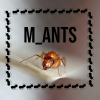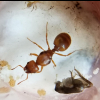- Formiculture.com
- Forums
- Gallery
- Members
- Member Map
- Chat

NickAnter's Temnothorax spp. Journal (chandleri worker!)
Started By
NickAnter
, Aug 24 2019 8:43 AM
113 replies to this topic
#41
 Offline
-
Posted August 11 2020 - 10:17 AM
Offline
-
Posted August 11 2020 - 10:17 AM
Huge flight of these around 9:30 am. Sadly only got four, as an RV drove through the swarm. I checked the area 30 mins later and it was like they disapeared. They werent under any rocks, or even roaming. Strange. Anyway, hopefully I will find some night flying ones tonight on the blacklight.
Hi there! I went on a 6 month or so hiatus, in part due, and in part cause of the death of my colonies.
However, I went back to the Sierras, and restarted my collection, which is now as follows:
Aphaenogaster uinta, Camponotus vicinus, Camponotus modoc, Formica cf. aserva, Formica cf. micropthalma, Formica cf. manni, Formica subpolita, Formica cf. subaenescens, Lasius americanus, Manica invidia, Pogonomyrmex salinus, Pogonomyrmex sp. 1, Solenopsis validiuscula, & Solenopsis sp. 3 (new Sierra variant).
#42
 Offline
-
Posted August 11 2020 - 10:24 AM
Offline
-
Posted August 11 2020 - 10:24 AM
Nice! Good luck! Where was this at?
Veromessor pergandei
Veromessor andrei
Crematogaster sp.
Pogonomyrmex cf cali and rugosus
Various Pheidole
C. yogi
#43
 Offline
-
Posted August 11 2020 - 10:27 AM
Offline
-
Posted August 11 2020 - 10:27 AM
Near Lake Crowley, in the Eastern Sierras.
Hi there! I went on a 6 month or so hiatus, in part due, and in part cause of the death of my colonies.
However, I went back to the Sierras, and restarted my collection, which is now as follows:
Aphaenogaster uinta, Camponotus vicinus, Camponotus modoc, Formica cf. aserva, Formica cf. micropthalma, Formica cf. manni, Formica subpolita, Formica cf. subaenescens, Lasius americanus, Manica invidia, Pogonomyrmex salinus, Pogonomyrmex sp. 1, Solenopsis validiuscula, & Solenopsis sp. 3 (new Sierra variant).
#44
 Offline
-
Posted August 11 2020 - 10:30 AM
Offline
-
Posted August 11 2020 - 10:30 AM
I'm jealous. My Temnothorax died for no reason.
Veromessor pergandei
Veromessor andrei
Crematogaster sp.
Pogonomyrmex cf cali and rugosus
Various Pheidole
C. yogi
#45
 Offline
-
Posted August 11 2020 - 10:33 AM
Offline
-
Posted August 11 2020 - 10:33 AM
Hopefully more will fly tomorrow. There were thousands in the air, so they are probably fairly common, though I never see workers. Tomorrow they will probably fly again. If I find more seemingly fertile ones, which I only have 2 of as of now, ill sell them.
- M_Ants likes this
Hi there! I went on a 6 month or so hiatus, in part due, and in part cause of the death of my colonies.
However, I went back to the Sierras, and restarted my collection, which is now as follows:
Aphaenogaster uinta, Camponotus vicinus, Camponotus modoc, Formica cf. aserva, Formica cf. micropthalma, Formica cf. manni, Formica subpolita, Formica cf. subaenescens, Lasius americanus, Manica invidia, Pogonomyrmex salinus, Pogonomyrmex sp. 1, Solenopsis validiuscula, & Solenopsis sp. 3 (new Sierra variant).
#46
 Offline
-
Posted August 11 2020 - 5:01 PM
Offline
-
Posted August 11 2020 - 5:01 PM
Here is a picture of one of the likely fertile queens: 

- M_Ants likes this
Hi there! I went on a 6 month or so hiatus, in part due, and in part cause of the death of my colonies.
However, I went back to the Sierras, and restarted my collection, which is now as follows:
Aphaenogaster uinta, Camponotus vicinus, Camponotus modoc, Formica cf. aserva, Formica cf. micropthalma, Formica cf. manni, Formica subpolita, Formica cf. subaenescens, Lasius americanus, Manica invidia, Pogonomyrmex salinus, Pogonomyrmex sp. 1, Solenopsis validiuscula, & Solenopsis sp. 3 (new Sierra variant).
#47
 Offline
-
Posted August 13 2020 - 8:47 AM
Offline
-
Posted August 13 2020 - 8:47 AM
So remember how there was the two different kinds of workers? Well, I managed to find a wild colony, and it had boh kinds of workers. I highly doubt it is a parasitic relation, but, what I do think is that the orange ones are kind of like majors, as they are larger. It could also have something to do with diet and resources as well, I'm not sure. But for sure, this is a species that is in desperate need of study. I have 4 likely fertile queens now, having caught one more queen in a flight earlier today. My goal is to raise them to maturity, to see if my theory is correct. I will soon get video of the wild colony.
Edited by NickAnter, August 13 2020 - 8:48 AM.
- CatsnAnts, AntsDakota and Antkid12 like this
Hi there! I went on a 6 month or so hiatus, in part due, and in part cause of the death of my colonies.
However, I went back to the Sierras, and restarted my collection, which is now as follows:
Aphaenogaster uinta, Camponotus vicinus, Camponotus modoc, Formica cf. aserva, Formica cf. micropthalma, Formica cf. manni, Formica subpolita, Formica cf. subaenescens, Lasius americanus, Manica invidia, Pogonomyrmex salinus, Pogonomyrmex sp. 1, Solenopsis validiuscula, & Solenopsis sp. 3 (new Sierra variant).
#48
 Offline
-
Posted August 13 2020 - 10:47 AM
Offline
-
Posted August 13 2020 - 10:47 AM
Nice.
Ants I have: Tapinoma sessile(2 queen colony). RED MORPH Camponotus neacticus(now has pupae!), Tetramorium immigrans (x3), Aphaenogaster sp, Temnothorax sp, Brachymyrmex sp. possibly infertile ![]() , Ponera pennsylvanica, and Pheidole morrisi!
, Ponera pennsylvanica, and Pheidole morrisi! ![]()
Other insects: Polistes sp. Queen
Ants I need: Pheidole sp., Trachymyrmex sp., Crematogaster cerasi , Dorymyrmex sp. Most wanted: Pheidole morrisii
#49
 Offline
-
Posted August 13 2020 - 4:55 PM
Offline
-
Posted August 13 2020 - 4:55 PM
Temnothorax do display mild polymorphism, so its certainly possible.
- CatsnAnts likes this
#50
 Offline
-
Posted August 13 2020 - 4:59 PM
Offline
-
Posted August 13 2020 - 4:59 PM
Temnothorax do display mild polymorphism, so its certainly possible.
My mature colony has workers as big as the queen, and workers that are half the size of the queen. Pretty large variation, some of the worker pupae even looks like alate pupae at first glance.
Edited by CatsnAnts, August 13 2020 - 4:59 PM.
Spoiler
#51
 Offline
-
Posted August 21 2020 - 8:57 AM
Offline
-
Posted August 21 2020 - 8:57 AM
One of the queens has an egg! Hopefully more of them will follow. I have what I think are 12 good queens. I will be selling off most of them when they get workers: I don't want more colonies than I can take care of.
Hi there! I went on a 6 month or so hiatus, in part due, and in part cause of the death of my colonies.
However, I went back to the Sierras, and restarted my collection, which is now as follows:
Aphaenogaster uinta, Camponotus vicinus, Camponotus modoc, Formica cf. aserva, Formica cf. micropthalma, Formica cf. manni, Formica subpolita, Formica cf. subaenescens, Lasius americanus, Manica invidia, Pogonomyrmex salinus, Pogonomyrmex sp. 1, Solenopsis validiuscula, & Solenopsis sp. 3 (new Sierra variant).
#52
 Offline
-
Posted September 29 2020 - 11:08 AM
Offline
-
Posted September 29 2020 - 11:08 AM
Two queens have pupae. The two queen group(now only one, second was murdered) has six larvae and one pupa, whereas the best single queen has 2 larvae, and one pupa. They should get workers in a few days, as the remaining queen from the two queen group's pupa is light orange. Pictures will come when workers arrive.
- Ants_Dakota likes this
Hi there! I went on a 6 month or so hiatus, in part due, and in part cause of the death of my colonies.
However, I went back to the Sierras, and restarted my collection, which is now as follows:
Aphaenogaster uinta, Camponotus vicinus, Camponotus modoc, Formica cf. aserva, Formica cf. micropthalma, Formica cf. manni, Formica subpolita, Formica cf. subaenescens, Lasius americanus, Manica invidia, Pogonomyrmex salinus, Pogonomyrmex sp. 1, Solenopsis validiuscula, & Solenopsis sp. 3 (new Sierra variant).
#53
 Offline
-
Posted October 3 2020 - 9:36 AM
Offline
-
Posted October 3 2020 - 9:36 AM
The former duo queen has a worker! So adorable:

Here is the other queen, who is a bit larger, and is seemingly always full of eggs:

Here is the other queen, who is a bit larger, and is seemingly always full of eggs:

- M_Ants and TestSubjectOne like this
Hi there! I went on a 6 month or so hiatus, in part due, and in part cause of the death of my colonies.
However, I went back to the Sierras, and restarted my collection, which is now as follows:
Aphaenogaster uinta, Camponotus vicinus, Camponotus modoc, Formica cf. aserva, Formica cf. micropthalma, Formica cf. manni, Formica subpolita, Formica cf. subaenescens, Lasius americanus, Manica invidia, Pogonomyrmex salinus, Pogonomyrmex sp. 1, Solenopsis validiuscula, & Solenopsis sp. 3 (new Sierra variant).
#54
 Offline
-
Posted October 8 2020 - 8:14 PM
Offline
-
Posted October 8 2020 - 8:14 PM
The other queen has a worker as well, and it too is slightly larger, but with the exact same coloration. They are actually pretty aggressive, especially colony 1, which attacks anything that goes near. A third queen has a pupa as well. I will likely sell that queen.
- M_Ants likes this
Hi there! I went on a 6 month or so hiatus, in part due, and in part cause of the death of my colonies.
However, I went back to the Sierras, and restarted my collection, which is now as follows:
Aphaenogaster uinta, Camponotus vicinus, Camponotus modoc, Formica cf. aserva, Formica cf. micropthalma, Formica cf. manni, Formica subpolita, Formica cf. subaenescens, Lasius americanus, Manica invidia, Pogonomyrmex salinus, Pogonomyrmex sp. 1, Solenopsis validiuscula, & Solenopsis sp. 3 (new Sierra variant).
#55
 Offline
-
Posted October 9 2020 - 4:42 AM
Offline
-
Posted October 9 2020 - 4:42 AM
Cool, I never got why people in california liked Temnothorax so much are they rare? The only Temnothorax i want that are in va are curvisponis... i spelled dat wrong.
We don’t talk about that
#56
 Offline
-
Posted October 9 2020 - 2:26 PM
Offline
-
Posted October 9 2020 - 2:26 PM
Well, no one else on this forum has this species to my knowledge. And, this species is way larger than curvispinosus.
Hi there! I went on a 6 month or so hiatus, in part due, and in part cause of the death of my colonies.
However, I went back to the Sierras, and restarted my collection, which is now as follows:
Aphaenogaster uinta, Camponotus vicinus, Camponotus modoc, Formica cf. aserva, Formica cf. micropthalma, Formica cf. manni, Formica subpolita, Formica cf. subaenescens, Lasius americanus, Manica invidia, Pogonomyrmex salinus, Pogonomyrmex sp. 1, Solenopsis validiuscula, & Solenopsis sp. 3 (new Sierra variant).
#57
 Offline
-
Posted November 1 2020 - 6:30 AM
Offline
-
Posted November 1 2020 - 6:30 AM
Queen 1; 3 workers, a larva, and a pupa.
Queen 2: 4 workers, 2 pupae, larvae, and eggs. One pupa is very large.
Queen 3: 1 worker, assorted brood.
Queen 4: 1 worker.
Queen 2: 4 workers, 2 pupae, larvae, and eggs. One pupa is very large.
Queen 3: 1 worker, assorted brood.
Queen 4: 1 worker.
Hi there! I went on a 6 month or so hiatus, in part due, and in part cause of the death of my colonies.
However, I went back to the Sierras, and restarted my collection, which is now as follows:
Aphaenogaster uinta, Camponotus vicinus, Camponotus modoc, Formica cf. aserva, Formica cf. micropthalma, Formica cf. manni, Formica subpolita, Formica cf. subaenescens, Lasius americanus, Manica invidia, Pogonomyrmex salinus, Pogonomyrmex sp. 1, Solenopsis validiuscula, & Solenopsis sp. 3 (new Sierra variant).
#58
 Offline
-
Posted November 1 2020 - 7:02 AM
Offline
-
Posted November 1 2020 - 7:02 AM

- M_Ants likes this
Hi there! I went on a 6 month or so hiatus, in part due, and in part cause of the death of my colonies.
However, I went back to the Sierras, and restarted my collection, which is now as follows:
Aphaenogaster uinta, Camponotus vicinus, Camponotus modoc, Formica cf. aserva, Formica cf. micropthalma, Formica cf. manni, Formica subpolita, Formica cf. subaenescens, Lasius americanus, Manica invidia, Pogonomyrmex salinus, Pogonomyrmex sp. 1, Solenopsis validiuscula, & Solenopsis sp. 3 (new Sierra variant).
#59
 Offline
-
Posted November 5 2020 - 7:22 PM
Offline
-
Posted November 5 2020 - 7:22 PM

6 workers now.

- AnthonyP163 and M_Ants like this
Hi there! I went on a 6 month or so hiatus, in part due, and in part cause of the death of my colonies.
However, I went back to the Sierras, and restarted my collection, which is now as follows:
Aphaenogaster uinta, Camponotus vicinus, Camponotus modoc, Formica cf. aserva, Formica cf. micropthalma, Formica cf. manni, Formica subpolita, Formica cf. subaenescens, Lasius americanus, Manica invidia, Pogonomyrmex salinus, Pogonomyrmex sp. 1, Solenopsis validiuscula, & Solenopsis sp. 3 (new Sierra variant).
#60
 Offline
-
Posted November 30 2020 - 1:49 PM
Offline
-
Posted November 30 2020 - 1:49 PM
Colony 1: 9 workers now, and 10 brood of all stages. This colony triumphs them all as usual. Fed them a baby mealworm today, and the workers bit it, then carried it over to the brood pile, and slowly processed it. I watched them feed little bits of it to the larvae. Very cool in my opinion.
Colony 2: 3 workers, at least 10 brood of all stages(3rd queen to get workers) This colony has a worker that is purely a rust color. None of the others do, and this queen seems to be the most productive, despite the low worker count. They would have had 4, but, it came out malformed.
Colony 3:3 workers, 1 larva(Used to be bloated queen)
Colony 4: 1 worker, one egg, one larva.(Last queen to get workers)
- M_Ants likes this
Hi there! I went on a 6 month or so hiatus, in part due, and in part cause of the death of my colonies.
However, I went back to the Sierras, and restarted my collection, which is now as follows:
Aphaenogaster uinta, Camponotus vicinus, Camponotus modoc, Formica cf. aserva, Formica cf. micropthalma, Formica cf. manni, Formica subpolita, Formica cf. subaenescens, Lasius americanus, Manica invidia, Pogonomyrmex salinus, Pogonomyrmex sp. 1, Solenopsis validiuscula, & Solenopsis sp. 3 (new Sierra variant).
0 user(s) are reading this topic
0 members, 0 guests, 0 anonymous users

















